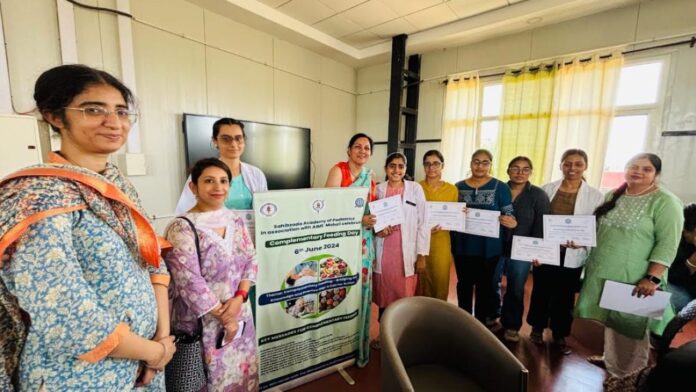SAS Nagar, June 06, 2024
A Complementary Feeding Day event was celebrated at AIMS Mohali, in collaboration with the local IAP. Dr. Prabhjit Secretary of Sahibzada Academy of Pediatrics Mohali stated that the IAP celebrates Complementary Feeding Day on the sixth day of the sixth month to underscore the importance of initiating complementary feeding at the appropriate time.
This initiative aimed to address the significant gap in nutrition knowledge and practices in India and Punjab, where approximately 12% of infants aged 6-23 months receive the minimum acceptable diet.
MBBS students, working in teams,named after the word “Nourish” in different languages tackled various clinical scenarios and collaborated with nutritionists to educate caregivers on appropriate complementary feeding practices. The event was judged by esteemed experts, including Dr. Deepak Chawla, Professor and Head of Neonatology at GMCH 32, Dr. Sunny Narula, Consultant Pediatrician Motherhood Hospital, Dr. Sunil Aggarwal, Consultant Neonatologist Fortis, Dr Ashish DM ( PGI ) and Dr Amrit HOD Community Medicine and Dr Jasmine AP Pediatrics AIMS.
In addition the teams were also evaluated by Nutritionists Dr Sunita Malhotra Ex HOD PGI and Dr Poonam Additional Professor School of Public Health & Community Medicine PGI Chandigarh.
Team Pitat ( Nourish in Russian ) comprising Ashu, Disha, Sargam, Shreya & Tanvi was adjudged as first.
ICDS functionaries under the leadership of Ms Sukhdev CDPO from Chandigarh explained the importance of Poshan Abhiyan in improving the nutrition of infants and children. They informed that Annaprashan, the first rice eating/ solid food initiation ceremony, marks a significant milestone in a baby’s life at the age of 6 months is celebrated by them in Anganwadi of Chandigarh. During the event, the importance of starting complementary foods at around 6 months of age, while continuing to breastfeed, is emphasized. Continuing breastfeeding alongside complementary foods until at least 2 years of age or beyond is crucial. Caregivers are advised to include a variety of nutrient-rich foods, such as fruits, vegetables, grains, legumes, and animal-source foods, in the diet. Starting with pureed or mashed foods and gradually progressing to finely chopped or soft pieces as the child grows older and develops chewing skills is recommended.
Attention is drawn to the need for feeding complementary foods 2-3 times a day at 6-8 months, increasing to 3-4 times a day with 1-2 nutritious snacks from 9-23 months. Dr Deepak Chawla highlighted the importance of responsive feeding as essential for making mealtime a positive experience. This involves paying attention to the child’s hunger and fullness cues.
Dr Amarpreet Head Dept of Pediatrics advised to limit the intake of foods high in sugar, salt, and unhealthy fats, and to avoid sugary drinks, offering water or breast milk/formula instead.
Dr Abha Dietician at AIMS Mohali informed us about an important aspect of complementary feeding – “Diversity score”, which refers to the variety of different food groups consumed over a given period. A higher diversity score indicates a more varied and potentially more nutritious diet. WHO guidelines specify that children aged 6-23 months should consume foods from at least five of the following eight food groups daily to meet the minimum dietary diversity: breast milk , grains, roots, and tubers; legumes and nuts; dairy products; flesh foods (meat, fish, poultry, and liver/organ meats); eggs; vitamin-A rich fruits and vegetables; and other fruits and vegetables.
Director Principal Bhavneet Bharti emphasized that this hands-on approach offers an immersive learning experience, enabling students to grasp the vital importance of complementary feeding. This initiative not only addresses malnutrition but also aligns with the nation’s broader health objectives, empowering future healthcare professionals to make a tangible impact on child nutrition.

 हिंदी
हिंदी






